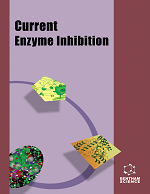- Home
- A-Z Publications
- Current Enzyme Inhibition
- Previous Issues
- Volume 18, Issue 2, 2022
Current Enzyme Inhibition - Volume 18, Issue 2, 2022
Volume 18, Issue 2, 2022
-
-
The Inhibition of Glutathione S-Transferases and Butyrylcholinesterase by Antidepressants: A Mini-Review on Enzyme-Drug Interactions
More LessAuthors: Victor Markus, Özlem Dalmızrak, Kerem Teralı and Nazmi ÖzerBackground: Compromises in the cellular enzymatic defense barrier can increase the duration of exposure to electrophiles and the severity of toxicity they may incur. Objective: In this mini-review, we discuss the inhibition of the enzymatic defense systems by different antidepressants commonly prescribed worldwide as well as herbal products used for various forms of depression. Methods: Our work primarily focused o Read More
-
-
-
Recent PARP Inhibitor Advancements in Cancer Therapy: A Review
More LessPoly [ADP-ribose] polymerase-1 [PARP-1] is a chromatin-bound nuclear enzyme that gets activated by DNA damage. It facilitates DNA repair by binding to DNA breaks and attracting DNA repair proteins to the site of damage. Increased PARP-1 expression is observed in melanomas, breast cancer, lung cancer, and other neoplastic diseases. PARP-1 interacts directly and indirectly with various oncogenic proteins and regulate Read More
-
-
-
Alpha-glucosidase and Alpha-amylase Inhibition Activity of Avocado Fruit of Nepalese Origin
More LessAuthors: Kamal Dhakal, Dipesh Shrestha, Tamlal Pokhrel, Devi P. Bhandari and Achyut AdhikariBackground: Diabetes has become a major health problem due to its high prevalence, morbidity, and mortality rate. Reducing postprandial hyperglycemia has become the main target in the treatment of diabetes mellitus. So, developing new drugs with fewer side effects has been a major priority. Objective: The main objective of this study is to investigate total phenolic and flavonoid content, antioxidant activity, α-glu Read More
-
-
-
Molecular Docking, In vitro Antioxidant, and In vivo Hepatoprotective Activity of Methanolic Extract of Calotropis gigantea leaves in Carbon Tetrachloride-induced Liver Injury in Rats
More LessAuthors: Shripad Bairagi, Prashant Ghule and Ritu GilhotraBackground: Calotropis gigantea (Asclepiadaceae), a wildly growing plant, has several purported therapeutic characteristics and treats toothache and earache, sprains, anxiety, pain, epilepsy, and mental disorders. Objective: The purpose of this study was to determine the in vitro antioxidant and in vivo hepatoprotective capabilities of a methanolic extract of Calotropis gigantea leaves (CGL) against carbon tetrachloride-induce Read More
-
-
-
Identification and Validation of Hydroxychavicol from Betel Leaf as a Promising Breast Cancer Inhibitor: An In vitro and In silico Analysis
More LessAuthors: P. Sangavi, K. Langeswaran and R. SangeethaAims: This study aimed at identifying promising breast cancer inhibitors through in vitro and in silico studies. Background: Piper betel. L. is a traditional herb used for varied ailments. Objective: The present study is designed to evaluate the anti-carcinogenic potency of HC against the MCF-7 cell line by in vitro analysis. Further in silico examination was performed to detect and formulate protein-ligand complex of HC using m Read More
-
-
-
Contribution to Pharmacological Valorisation of Algerian Arctium minus (Hill) Bernh. Subsp. Atlanticum (Pomel) Maire; Antioxidant an d Acetylcholinesterase Inhibitory Activities
More LessBackground: The traditional pharmacopoeia is full of potential resources for molecules with therapeutic effects involving the inhibition of enzymes linked to some diseases. Objective: This work aimed to test in vitro neuroprotective activity against Alzheimer's disease (AD) combined with the antioxidant effect of root extracts obtained by water, water/methanol, and ethyl acetate of the endemic Arctium minus. subsp. Atlanticu Read More
-
-
-
L-Proline Catalyzed Knoevenagel Condensation of Aldehydes with Active Methylene Compounds and Their Molecular Modeling Studies for Anti-SARS CoV-2 Potentials
More LessIntroduction: An efficient one-pot synthesis of 2-alkylidene/arylidene derivatives was reported from active methylene compounds such as malononitrile/ethyl cyanoacetate/5-methyl-2,4- dihydro-3H-pyrazol-3-one and aldehydes in the presence of 10 mol% of L-proline (ethanol at room temperature). Methods: All derivatives were obtained in good to excellent yields. The structures of the synthesized compounds were con Read More
-
Volumes & issues
-
Volume 20 (2024)
-
Volume 19 (2023)
-
Volume 18 (2022)
-
Volume 17 (2021)
-
Volume 16 (2020)
-
Volume 15 (2019)
-
Volume 14 (2018)
-
Volume 13 (2017)
-
Volume 12 (2016)
-
Volume 11 (2015)
-
Volume 10 (2014)
-
Volume 9 (2013)
-
Volume 8 (2012)
-
Volume 7 (2011)
-
Volume 6 (2010)
-
Volume 5 (2009)
-
Volume 4 (2008)
-
Volume 3 (2007)
-
Volume 2 (2006)
-
Volume 1 (2005)
Most Read This Month
Article
content/journals/cei
Journal
10
5
false
en


